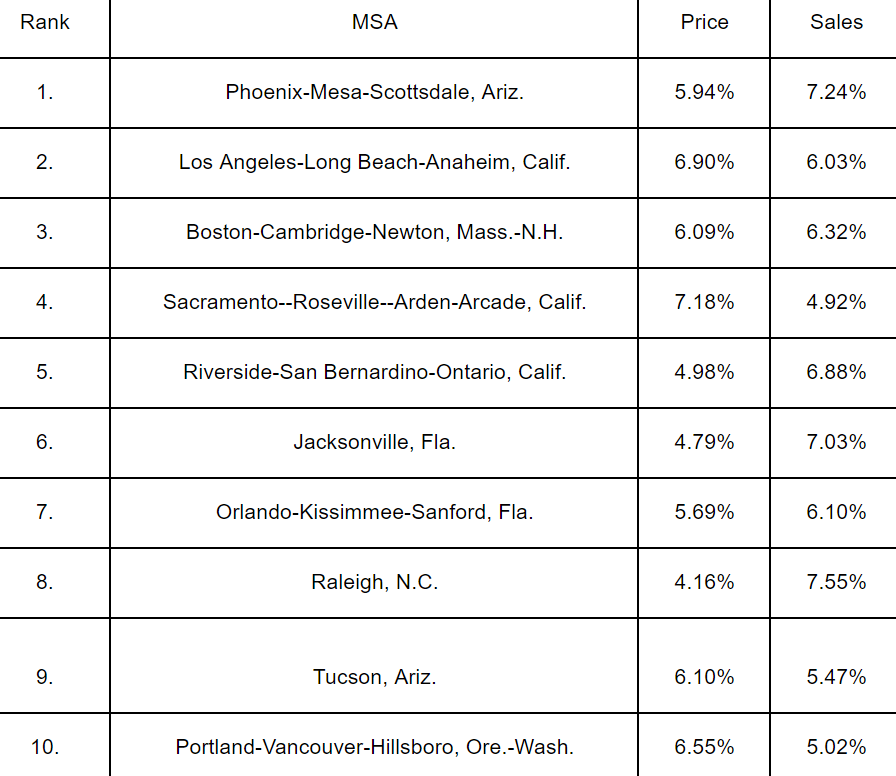Housing is expected to downshift next year as the post-election economy sets in, driven by a deceleration in home price growth, according to realtor.com®’s recently released 2017 housing forecast. The forecast projects home prices nationally growing at a rate of 3.9 percent, down from 2016’s 4.9 percent estimate, and an appreciation slowdown of 1 percent or more in nearly half of the U.S.’ top 100 metropolitan areas.
“Multiple factors are coming together,” says realtor.com Chief Economist Jonathan Smoke. “One is a continued trend toward moderation—basically the effect of seeing all of the rebounds coming off of the distress, the foreclosure years finally well behind us, so there’s no longer that dead cat bounce that was occurring in some markets. Second…we’re now in record price territory in many places in the country, so that’s starting to have its own moderating effect. We’re seeing that evident in the fact that more markets in our forecast represent a deceleration in price trend as opposed to an acceleration in price trend.”
The Lakeland-Winter Haven, Fla. area tops the list of 46 markets projected to experience an appreciation slowdown in 2017, followed by Durham-Chapel Hill, N.C. and Jackson, Miss.
Mortgage rates, which last week treaded above 4 percent for the first time this year, are projected to reach 4.5 percent, according to the forecast. The Federal Reserve is widely expected to raise the key interest rate in December.
“A new wrinkle is the higher mortgage rates,” Smoke says. “They have an impact on the potential of the buying pool in high-cost areas in that they really start to challenge qualifications from an affordability perspective, so, as a result, they tend to have a dampening effect. Our forecast would imply that we’re expecting, in addition the December move, likely two to three more moves next year.”
Higher mortgage rates do, however, have the potential to result in less stringent enforcement action, which, coupled with changes per the Trump Administration, could open up credit opportunities closed off to otherwise qualified homebuyers.
“What I’m expecting is that those trends toward more conservatism will likely improve simply because mortgage rates are higher,” says Smoke. “An even more important factor is the fact that the refi market goes away when mortgage rates are above 4 percent; if want to keep their lending operation performing similarly, then they have to turn to the purchase market more. I think the consumer’s going to win in that perspective.”
Leading positive price movement—though lessened compared to 2016—will be the Phoenix-Mesa-Scottsdale, Ariz. area, ranked the No. 1 housing market of 2017 in the forecast. The area is projected to see prices grow 5.94 percent and sales grow 7.24 percent. Los Angeles-Long Beach-Anaheim, Calif., Boston-Cambridge-Newton, Mass.-N.H., Sacramento-Roseville-Arden-Arcade, Calif., and Riverside-San Bernardino-Ontario, Calif. round out the top five of the forecast’s ranking.
Realtor.com’s 2017 Housing Forecast – Top 100 Metros
Twenty-six of the top 100 metropolitan areas, as well, are projected to experience appreciation of 1 percent or more, including the Greensboro-High Point, N.C., Akron, Ohio, and Baltimore-Columbia-Townson, Md. areas.
The forecast projects the homeownership rate to stabilize at 63.5 percent after hitting a 50-year low point (62.9 percent) in the second quarter of 2016. The homeownership rate rallied to the 63.5 percent-mark in the third quarter.
Existing- and new-home sales, additionally, are projected to grow 1.9 percent (to 5.46 million) and 10 percent, respectively, while new-home construction starts are projected to grow 3 percent.
“We are forecasting marginally better inventory as a result of new construction continuing to expand,” Smoke says. “It’s not going to materially change the supply dynamic. New construction is ultimately the safety valve for pressure from a supply/demand standpoint, so continued growth there starts to alleviate price pressure—the release has to come from market.”
Demographic activity overall will have a substantial impact on housing in 2017, as well. The forecast projects baby boomers and millennials will power demand over the next decade, with millennials comprising 33 percent of homebuyers and boomers, 30 percent next year. Concentrations of these groups are in many of the top markets ranked in the forecast; millennials, however, are also projected to make waves in Midwestern cities, including Madison, Wis., Columbus, Ohio, and Omaha, Neb., where they currently hold 42 percent marketshare.
For more information, please visit www.realtor.com.
For the latest real estate news and trends, bookmark RISMedia.com.












